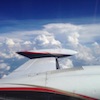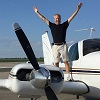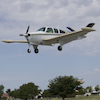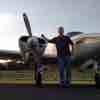24 Apr 2024, 09:13 [ UTC - 5; DST ]
|

| Username Protected |
Message |
|
Username Protected
|
Post subject: Re: Otto Aviation Celera 500L Flew This Week  Posted: Posted: 27 Aug 2020, 14:50 |
|
 |

|
|
 |

Joined: 04/20/15
Posts: 564
Post Likes: +318
Location: KFAT
|
|
Username Protected wrote:
I don’t know about zero. We had an rapid decompression at “50” and had time to get our masks on. We got below 25 pretty quick, but still had to sit with the flight doc for several hours after landing. An extra pilot on our crew went hypoxic because his O2 was not plugged in. He still had enough time to gang load his regulator and make a few interphone transmissions before he went full stupid. He was fine once I cleared off and plugged him in to the O2 system.
crazy! that must have been a wild ride
|
|
| Top |
|
|
Username Protected
|
Post subject: Re: Otto Aviation Celera 500L Flew This Week  Posted: Posted: 27 Aug 2020, 15:24 |
|
 |

|
|
 |

Joined: 11/08/12
Posts: 12799
Post Likes: +5226
Location: Jackson, MS (KHKS)
Aircraft: 1961 Cessna 172
|
|
Username Protected wrote: That's only good so long as you do not need to evacuate.
Because then, when everything goes pitch dark, how will you/cabin crew see which side is on fire, and open the proper door? So so so many good reasons to have actual windows. Cabin not cockpit. And easy enough to design emergency windows
|
|
| Top |
|
|
Username Protected
|
Post subject: Re: Otto Aviation Celera 500L Flew This Week  Posted: Posted: 27 Aug 2020, 16:32 |
|
 |

|
|
 |

Joined: 01/31/12
Posts: 3094
Post Likes: +5448
Company: French major
Location: France
Aircraft: Ejet
|
|
Username Protected wrote: That's only good so long as you do not need to evacuate.
Because then, when everything goes pitch dark, how will you/cabin crew see which side is on fire, and open the proper door? So so so many good reasons to have actual windows. Cabin not cockpit. And easy enough to design emergency windows
I fear I was not clear, since I was talking about cabin!
I did mention cabin crew.
First thing they do is look out the cabin and check if one engine is on fire. Again, super duper important to have a real windows.
_________________
Singham!
|
|
| Top |
|
|
Username Protected
|
Post subject: Re: Otto Aviation Celera 500L Flew This Week  Posted: Posted: 27 Aug 2020, 16:39 |
|
 |

|
|
 |

Joined: 11/08/12
Posts: 12799
Post Likes: +5226
Location: Jackson, MS (KHKS)
Aircraft: 1961 Cessna 172
|
|
Username Protected wrote:
I fear I was not clear, since I was talking about cabin!
I did mention cabin crew.
First thing they do is look out the cabin and check if one engine is on fire. Again, super duper important to have a real windows.
This plane has one engine at midline And a very few, very small windows would be adequate for safety purposes in a more traditional twin
|
|
| Top |
|
|
Username Protected
|
Post subject: Re: Otto Aviation Celera 500L Flew This Week  Posted: Posted: 27 Aug 2020, 16:44 |
|
 |

|

|
 |

Joined: 04/26/13
Posts: 19951
Post Likes: +19698
Location: Columbus , IN (KBAK)
Aircraft: 1968 Baron D55
|
|
Username Protected wrote: If the engine quits at FL500 and quits pumping air into the cabin, the first thing that happens is the outflow valve starts closing, trying to keep the cabin pressure constant. The cabin pressure will leak down over some period of time but it will not be an instantaneous decompression unless a large hole somehow opens in the fuselage (structural failure, door blows out, etc). I wasn't thinking engine failure. As you say, that would bleed down slowly and give much more time to respond and descend. However, it doesn't take a major structural failure to get a rapid decompression. Have the bleed inlet line on the pressurization pop off or blow out, as has happened, and the cabin will deflate pronto through the hole.
_________________
My last name rhymes with 'geese'.
|
|
| Top |
|
|
Username Protected
|
Post subject: Re: Otto Aviation Celera 500L Flew This Week  Posted: Posted: 28 Aug 2020, 08:40 |
|
 |

|
|
 |


Joined: 08/10/14
Posts: 1734
Post Likes: +832
Location: Northwest Arkansas (KVBT)
Aircraft: TBM850
|
|
Username Protected wrote: It needs some windows. The prototype does not have windows, which seems like a good way to reduce complexity and focus on proving performance at that stage. The production passenger variant does show windows. The dimensions, weights and fuel capacities are not listed, nor are takeoff performance, max payload or projected cost. Lots of questions here, also, it is ugly to my eye. That said, they do seem to have taken most of the interesting parts of the Raptor project and (secretly) produced a prototype that will get them to the next stage.
Please login or Register for a free account via the link in the red bar above to download files.
|
|
| Top |
|
|
Username Protected
|
Post subject: Re: Otto Aviation Celera 500L Flew This Week  Posted: Posted: 28 Aug 2020, 11:20 |
|
 |

|
|
 |


Joined: 12/19/11
Posts: 3303
Post Likes: +1424
Company: Bottom Line Experts
Location: KTOL - Toledo, OH
Aircraft: 2004 SR22 G2
|
|
|
As an aerodynamacist, there is lots to admire about the design. The fuselage shape resembles some of the most aggressive NLF airfoils with Stratford type recoveries, meaning that they offer the theoretical highest level of laminar flow but have horrific stall characteristics when implemented on a wing. As long as the flow stays attached to the fuselage, it could results in a very, very slippery fuselage drag coefficient. The pusher prop ensures the highest degree of laminar flow on the wings and fuselage. Someone mentioned similarities to the Piaggio Avanti and that's very true although aerodynamically, this is an even a more aggressive design.
Having worked on high laminar aircraft and pusher designs, I will also say this config poses a whole laundry list of concerns and challenges beyond the pressurization and power issues already discussed:
Windshield visibility
I can tell you that any piece of glass that's laid back at the angles they have the cockpit windshields set at will look like GARBAGE looking forward through them. Glass just has many imperfections and the more acute the angle you set the glass, the more these imperfections hinder visibility. I know the Avanti had significant challenges in the cockpit windows for visibility and manufacturing that are only going to be greatly excacerbated in the Celera. It may not be manufacturable or certifiable based on the current design.
Cooling
This has been touched on before in this thread but cooling a buried engine, especially one designed to operate at 50K ft is going to pose a major design challenge.
Structural Challenges
In order to get all the cooling and engine access working well, the aft fuselage will need massive holes which compromises the aft fuselage structure which has to take the forces of not only the horz & vertical tail but also the thrust loads from the prop. It's very challenging, doable but challenging.
Aft Fueselage Aerodynamics
This is probably the single largest challenge with this configuration. The prop is going to be drawing air in a very different angles and speeds at every different power setting which makes the tail surfaces behave vastly different than a conventional tail. I hope the team has oddles and oodles of CFD time or wind tunnel time to work all this out because it's going to behave very weird, especially at the edge of the envelope in cases like high power stalls, high flap settings, etc. Since the fuselage shape is so radical and will separate violently if it becomes separated, there's a risk that the tail surfaces and prop could be exposed to highly turbulent flow at corners of the operating envelope. Again, this could require tons of testing and CFD to work this out.
Overall, in cruise config, this design has the potential to achieve crazy low drag performance and be as efficient as they claim. However, in order to be certified, it's going to have to be well behaved in all configurations and outer portions of the flight envelope.
The Piaggio Avanti achieved the high levels of performance and efficiency they were shooting for and remains one of the most efficient production aircraft ever developed. However, they design team favored aerodynamics above all else, especially maintainability which was a high factor in it's lack of market success. The Celera could set new levels of efficiency but if they favor aerodynamics without also focusing on maintainability, they could be a market flop like the Avanti.
Personally, I love the design and hope they succeed.
_________________
Don Coburn
Corporate Expense Reduction Specialist
2004 SR22 G2
|
|
| Top |
|
|
Username Protected
|
Post subject: Re: Otto Aviation Celera 500L Flew This Week  Posted: Posted: 28 Aug 2020, 11:34 |
|
 |

|
|

Joined: 11/06/13
Posts: 404
Post Likes: +247
Location: KFTW-Fort Worth Meacham
Aircraft: C208B, AL18-115
|
|
|
Since I don't know anything about aerodynamics other than a few buzzwords-please indulge an ignorant buzzword laden question:
Over the last few decades, newer designs have focused on the intersectional drag where the wing attaches to the fuselage. This airplane appears to have the wings just stuck on with out any fairings. Am I missing something?
|
|
| Top |
|
|
Username Protected
|
Post subject: Re: Otto Aviation Celera 500L Flew This Week  Posted: Posted: 28 Aug 2020, 12:51 |
|
 |

|
|
 |

Joined: 08/26/15
Posts: 9546
Post Likes: +8781
Company: airlines (*CRJ,A320)
Location: Florida panhandle
Aircraft: Travel Air,T-6B,etc*
|
|
Username Protected wrote: As an aerodynamacist, there is lots to admire about the design. Well said, all of it. That's a very thoughtful assessment. A couple specific things I'm curious about but I can't seem to find are wingspan (appears to be about 80 feet) and weight (guessing 15,000lbs based on six seat business cabin, ± a few thousand...?). Its cruise point is interesting. High speed cruise at 400 knots and 50,000 feet is about 0.7 Mach. That's impressive Mach for a straight wing airplane; the straight wing Citations achieve the same but in the lower-mid 400 flight levels. The X and some Lears get up to FL510 but those are swept wings and going faster (higher Mach). Here is where I think it gets really interesting: that cruise point is also about 150 knots indicated. Without knowing the weight, dimensions, and airfoil of this airplane, it's a bit of guesswork for lift, stall margin, and where on the airframe's L:D curve that cruise point falls. I'm guessing that the clean (flaps up) stall speed is over 100 knots. The flaps cover most of the span but it's hard to tell if it has leading edge slats or much else about the wings (sophistication vs simplicity for the trailing edge flaps), and I'm assuming it's a 61 knot stall speed at full flaps and max gross weight. But the stall margin at 0.7 Mach isn't quite so simple- the airfoil's critical AoA at that Mach number is less than it would be when the airplane is at the same altitude/temperature at 100~ish knots indicated. And 150KIAS/400KTAS is the fast cruise; normal cruise will be either a little slower than that or perhaps 150+KIAS/350KTAS at a lower altitude. Either way, for this airplane to fly that high will a real balancing act and the autopilot will have to be very good. It is or will be an impressive achievement. 400KTAS and 0.7 Mach is also pushing it in terms of propulsion choices (no pun intended... "pushing" it...). That's simply fast for a propeller airplane that is intended to be efficient. Quote: Personally, I love the design and hope they succeed.  Me too! I'd like to believe they've been quietly chipping away at it, problem solving professionals who aren't focused on publicity. Last thought for now- the cabin mockup and the artists impressions/CGI pics have cabin windows. I think it's pretty smart to not bother with those for the prototype. There are good pro and con arguments for doing this on the prototype but it's a pragmatic choice.
|
|
| Top |
|
|
You cannot post new topics in this forum
You cannot reply to topics in this forum
You cannot edit your posts in this forum
You cannot delete your posts in this forum
You cannot post attachments in this forum
|

Terms of Service | Forum FAQ | Contact Us
BeechTalk, LLC is the quintessential Beechcraft Owners & Pilots Group providing a
forum for the discussion of technical, practical, and entertaining issues relating to all Beech aircraft. These include
the Bonanza (both V-tail and straight-tail models), Baron, Debonair, Duke, Twin Bonanza, King Air, Sierra, Skipper, Sport, Sundowner,
Musketeer, Travel Air, Starship, Queen Air, BeechJet, and Premier lines of airplanes, turboprops, and turbojets.
BeechTalk, LLC is not affiliated or endorsed by the Beechcraft Corporation, its subsidiaries, or affiliates.
Beechcraft™, King Air™, and Travel Air™ are the registered trademarks of the Beechcraft Corporation.
Copyright© BeechTalk, LLC 2007-2024
|
|
|
|



